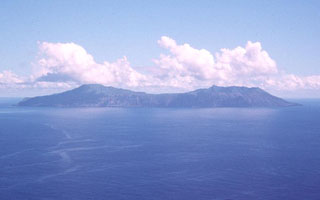Report on Anatahan (United States) — 28 November-4 December 2007
Smithsonian Institution / US Geological Survey
Weekly Volcanic Activity Report, 28 November-4 December 2007
Managing Editor: Sally Sennert.
Please cite this report as:
Global Volcanism Program, 2007. Report on Anatahan (United States) (Sennert, S, ed.). Weekly Volcanic Activity Report, 28 November-4 December 2007. Smithsonian Institution and US Geological Survey.
Anatahan
United States
16.35°N, 145.67°E; summit elev. 790 m
All times are local (unless otherwise noted)
The amplitude of volcanic tremor at Anatahan gradually increased through October and November and small explosions occurred during the last week of November. On 29 November, the Volcanic Alert Level was raised to Advisory and the Aviation Color Code was raised to Yellow based on the increase in seismicity.
Geological Summary. The elongate, 9-km-long island of Anatahan in the central Mariana Islands consists of a large stratovolcano with a 2.3 x 5 km compound summit caldera. The larger western portion of the caldera is 2.3 x 3 km wide, and its western rim forms the island's high point. Ponded lava flows overlain by pyroclastic deposits fill the floor of the western caldera, whose SW side is cut by a fresh-looking smaller crater. The 2-km-wide eastern portion of the caldera contained a steep-walled inner crater whose floor prior to the 2003 eruption was only 68 m above sea level. A submarine cone, named NE Anatahan, rises to within 460 m of the sea surface on the NE flank, and numerous other submarine vents are found on the NE-to-SE flanks. Sparseness of vegetation on the most recent lava flows had indicated that they were of Holocene age, but the first historical eruption did not occur until May 2003, when a large explosive eruption took place forming a new crater inside the eastern caldera.

